Analysis of Hospitality Interview Findings for Managing Foodservice Operations
VerifiedAdded on 2023/06/11
|10
|2415
|497
AI Summary
This study analyzes the findings of a hospitality interview for managing foodservice operations in a small Indian restaurant in Brisbane, Australia. It discusses the type of hospitality enterprise, cuisine offered, front and back house operations, cost control, and daily financial control of business operations.
Contribute Materials
Your contribution can guide someone’s learning journey. Share your
documents today.
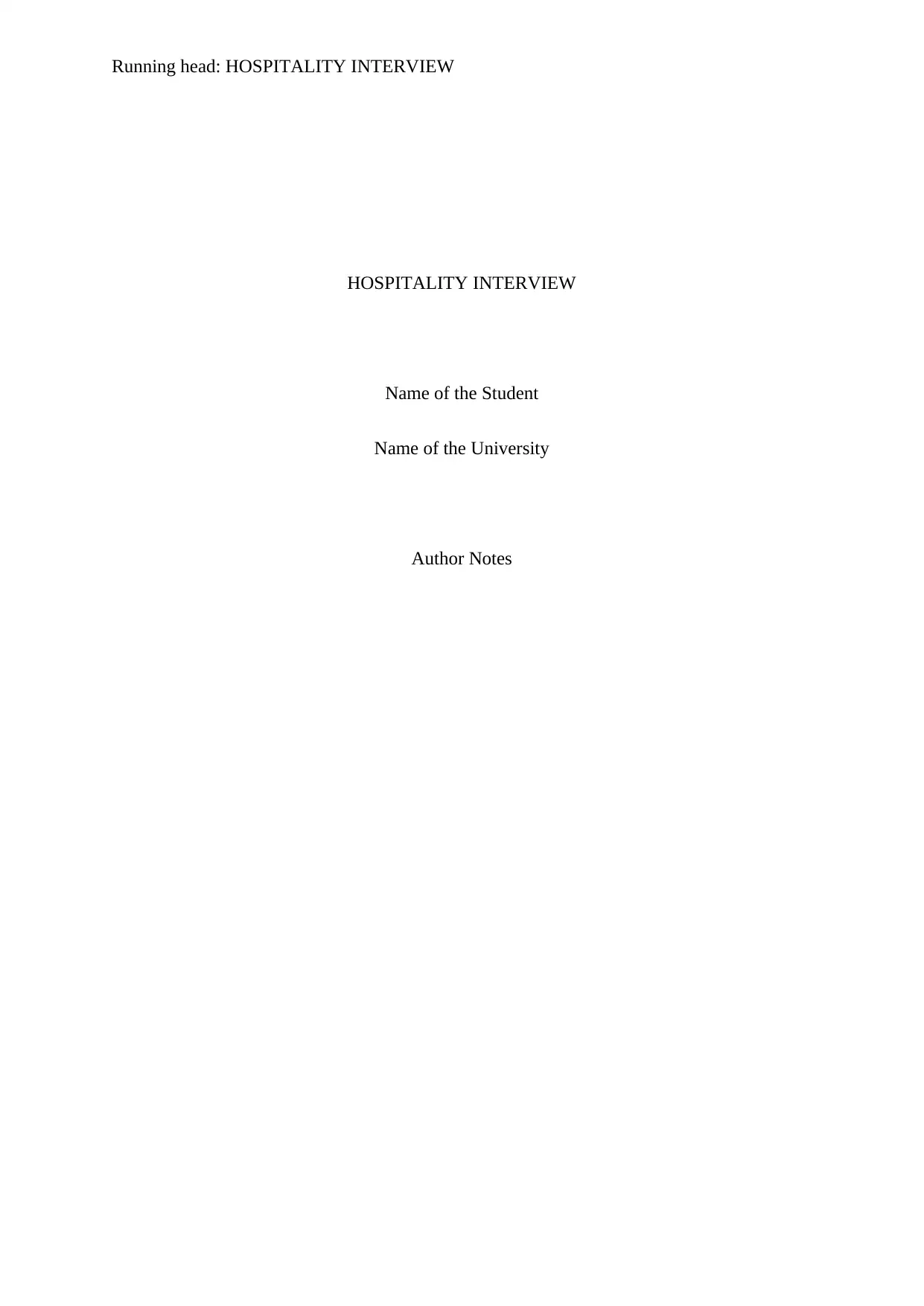
Running head: HOSPITALITY INTERVIEW
HOSPITALITY INTERVIEW
Name of the Student
Name of the University
Author Notes
HOSPITALITY INTERVIEW
Name of the Student
Name of the University
Author Notes
Secure Best Marks with AI Grader
Need help grading? Try our AI Grader for instant feedback on your assignments.

1
HOSPITALITY INTERVIEW
Table of Contents
Analysis of the Interview Findings............................................................................................2
1. Evaluation of the findings, and its effectiveness in managing foodservice operations.........2
1.1 Type of Hospitality Enterprise.........................................................................................2
1.2 Cuisine Offered at the Restaurant and the Factors for the selection................................2
1.3 What is Front House Operations?....................................................................................3
1.4 Cost Control in Front House Operations..........................................................................3
1.5 What is Back House Operations?.....................................................................................4
1.6 Cost Control in Back House Operations..........................................................................4
1.7 Daily Financial Control of Business Operations..............................................................5
3. References..............................................................................................................................6
4. Appendices.............................................................................................................................8
HOSPITALITY INTERVIEW
Table of Contents
Analysis of the Interview Findings............................................................................................2
1. Evaluation of the findings, and its effectiveness in managing foodservice operations.........2
1.1 Type of Hospitality Enterprise.........................................................................................2
1.2 Cuisine Offered at the Restaurant and the Factors for the selection................................2
1.3 What is Front House Operations?....................................................................................3
1.4 Cost Control in Front House Operations..........................................................................3
1.5 What is Back House Operations?.....................................................................................4
1.6 Cost Control in Back House Operations..........................................................................4
1.7 Daily Financial Control of Business Operations..............................................................5
3. References..............................................................................................................................6
4. Appendices.............................................................................................................................8
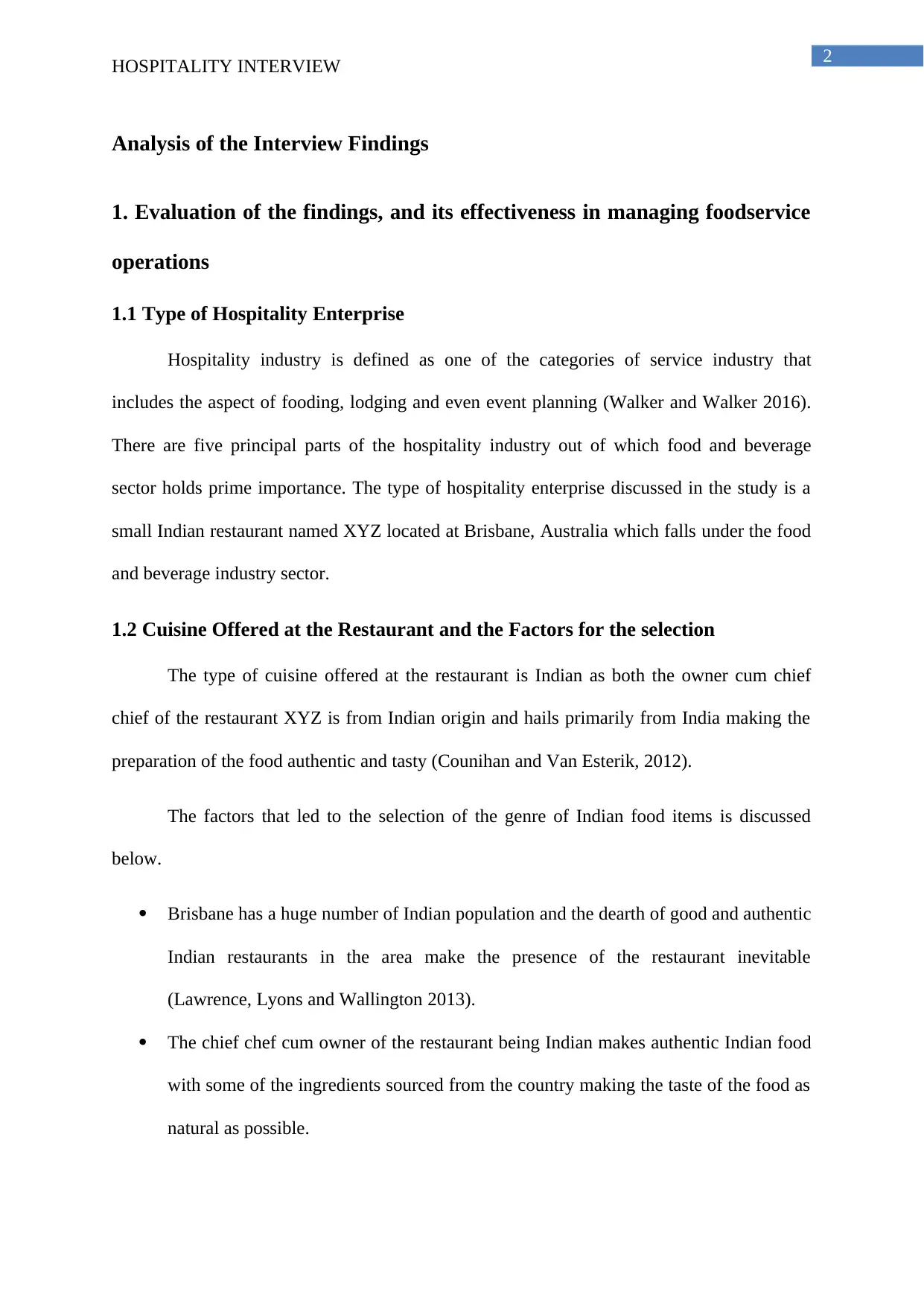
2
HOSPITALITY INTERVIEW
Analysis of the Interview Findings
1. Evaluation of the findings, and its effectiveness in managing foodservice
operations
1.1 Type of Hospitality Enterprise
Hospitality industry is defined as one of the categories of service industry that
includes the aspect of fooding, lodging and even event planning (Walker and Walker 2016).
There are five principal parts of the hospitality industry out of which food and beverage
sector holds prime importance. The type of hospitality enterprise discussed in the study is a
small Indian restaurant named XYZ located at Brisbane, Australia which falls under the food
and beverage industry sector.
1.2 Cuisine Offered at the Restaurant and the Factors for the selection
The type of cuisine offered at the restaurant is Indian as both the owner cum chief
chief of the restaurant XYZ is from Indian origin and hails primarily from India making the
preparation of the food authentic and tasty (Counihan and Van Esterik, 2012).
The factors that led to the selection of the genre of Indian food items is discussed
below.
Brisbane has a huge number of Indian population and the dearth of good and authentic
Indian restaurants in the area make the presence of the restaurant inevitable
(Lawrence, Lyons and Wallington 2013).
The chief chef cum owner of the restaurant being Indian makes authentic Indian food
with some of the ingredients sourced from the country making the taste of the food as
natural as possible.
HOSPITALITY INTERVIEW
Analysis of the Interview Findings
1. Evaluation of the findings, and its effectiveness in managing foodservice
operations
1.1 Type of Hospitality Enterprise
Hospitality industry is defined as one of the categories of service industry that
includes the aspect of fooding, lodging and even event planning (Walker and Walker 2016).
There are five principal parts of the hospitality industry out of which food and beverage
sector holds prime importance. The type of hospitality enterprise discussed in the study is a
small Indian restaurant named XYZ located at Brisbane, Australia which falls under the food
and beverage industry sector.
1.2 Cuisine Offered at the Restaurant and the Factors for the selection
The type of cuisine offered at the restaurant is Indian as both the owner cum chief
chief of the restaurant XYZ is from Indian origin and hails primarily from India making the
preparation of the food authentic and tasty (Counihan and Van Esterik, 2012).
The factors that led to the selection of the genre of Indian food items is discussed
below.
Brisbane has a huge number of Indian population and the dearth of good and authentic
Indian restaurants in the area make the presence of the restaurant inevitable
(Lawrence, Lyons and Wallington 2013).
The chief chef cum owner of the restaurant being Indian makes authentic Indian food
with some of the ingredients sourced from the country making the taste of the food as
natural as possible.

3
HOSPITALITY INTERVIEW
The Australian population strives to taste newer dishes with different flavours and
their affinity towards spicy food is also addressed in the Indian food items (Friel,
Barosh and Lawrence 2014).
The need for the place to have a different variety of restaurant other than the
generalised Italian and Chinese flavours.
1.3 What is Front House Operations?
Front House Operations of the restaurant includes the parts and corners of the
restaurant that is accessible by the regular customers as well as the staffs of the restaurant.
The parts of the restaurant considered under the Front House include restroom, dining room,
reception and the drinking bar where there is free entry of the people coming to the restaurant
and enjoying the meal (Sachs et al. 2014).
1.4 Cost Control in Front House Operations
The need of cost control in the front house operations of the restaurant is immense as
one of the most important factors in the restaurant business is ambiance and hygiene (Läikkö-
Roto and Nevas 2014). The owner of the restaurant should employ a good amount of resource
and money in providing the best and hygienic conditions for the customers who are coming
to the restaurant. However, like every business, the need to cut down cost so that the profit
margin can be maintained is also one of the major factors. As per the interview, the cost
control of XYZ restaurant in the front house is done by making sure that less employees are
associated with the servings and cleaning of the place (Flamholtz 2012). One of the major
ways in which the front desk can control the cost of the place is by making the waiters and
executives wear clothes from their own closet. If the restaurant offers clothing items to the
staffs then the cost of the place will increase manifold. Other major way to control cost is to
make the arrangements of home delivery and takeaway more than the dining in which will
reduce the cost of cutlery and decorations. Also smaller number of staffs can be appointed as
HOSPITALITY INTERVIEW
The Australian population strives to taste newer dishes with different flavours and
their affinity towards spicy food is also addressed in the Indian food items (Friel,
Barosh and Lawrence 2014).
The need for the place to have a different variety of restaurant other than the
generalised Italian and Chinese flavours.
1.3 What is Front House Operations?
Front House Operations of the restaurant includes the parts and corners of the
restaurant that is accessible by the regular customers as well as the staffs of the restaurant.
The parts of the restaurant considered under the Front House include restroom, dining room,
reception and the drinking bar where there is free entry of the people coming to the restaurant
and enjoying the meal (Sachs et al. 2014).
1.4 Cost Control in Front House Operations
The need of cost control in the front house operations of the restaurant is immense as
one of the most important factors in the restaurant business is ambiance and hygiene (Läikkö-
Roto and Nevas 2014). The owner of the restaurant should employ a good amount of resource
and money in providing the best and hygienic conditions for the customers who are coming
to the restaurant. However, like every business, the need to cut down cost so that the profit
margin can be maintained is also one of the major factors. As per the interview, the cost
control of XYZ restaurant in the front house is done by making sure that less employees are
associated with the servings and cleaning of the place (Flamholtz 2012). One of the major
ways in which the front desk can control the cost of the place is by making the waiters and
executives wear clothes from their own closet. If the restaurant offers clothing items to the
staffs then the cost of the place will increase manifold. Other major way to control cost is to
make the arrangements of home delivery and takeaway more than the dining in which will
reduce the cost of cutlery and decorations. Also smaller number of staffs can be appointed as
Secure Best Marks with AI Grader
Need help grading? Try our AI Grader for instant feedback on your assignments.
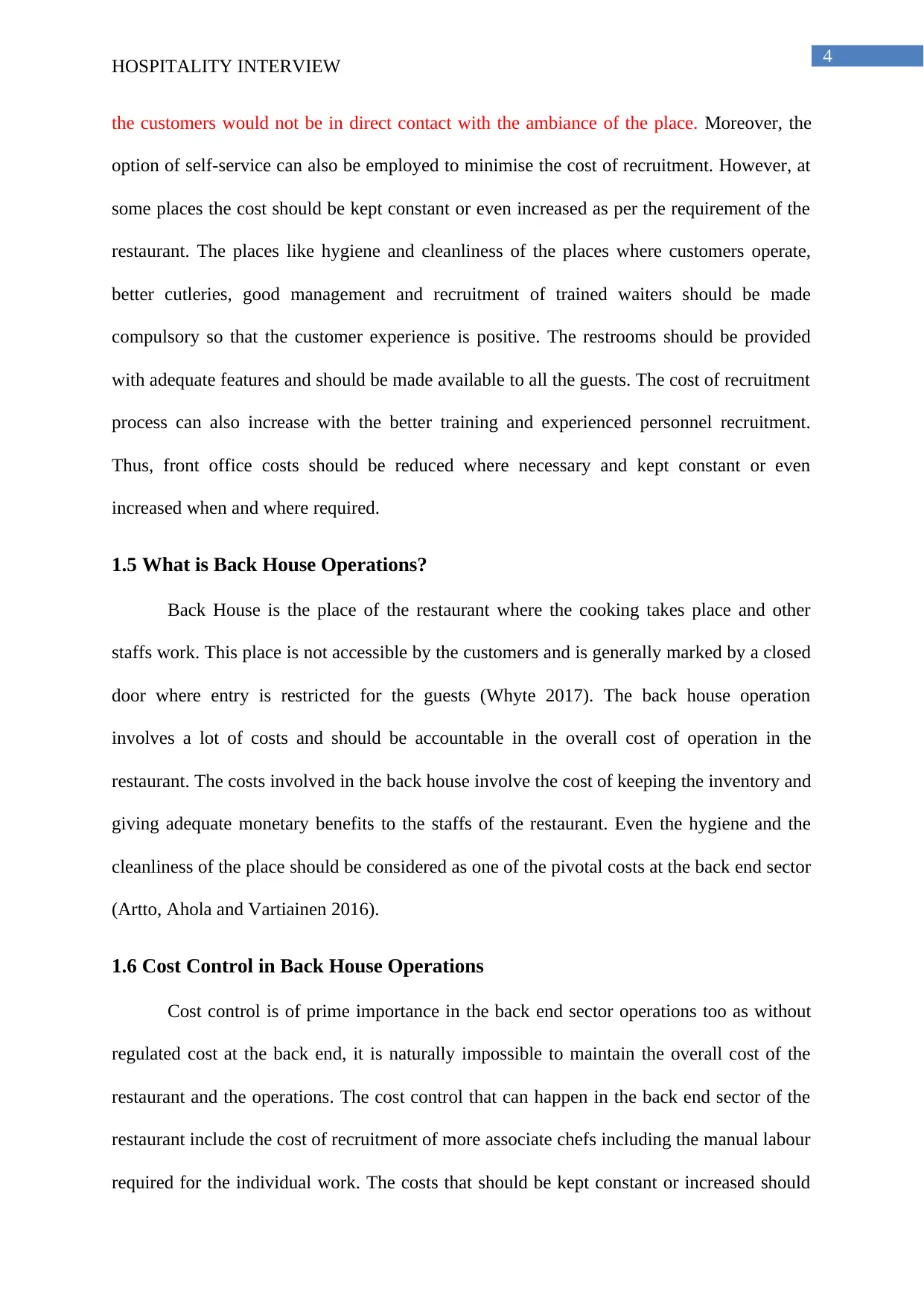
4
HOSPITALITY INTERVIEW
the customers would not be in direct contact with the ambiance of the place. Moreover, the
option of self-service can also be employed to minimise the cost of recruitment. However, at
some places the cost should be kept constant or even increased as per the requirement of the
restaurant. The places like hygiene and cleanliness of the places where customers operate,
better cutleries, good management and recruitment of trained waiters should be made
compulsory so that the customer experience is positive. The restrooms should be provided
with adequate features and should be made available to all the guests. The cost of recruitment
process can also increase with the better training and experienced personnel recruitment.
Thus, front office costs should be reduced where necessary and kept constant or even
increased when and where required.
1.5 What is Back House Operations?
Back House is the place of the restaurant where the cooking takes place and other
staffs work. This place is not accessible by the customers and is generally marked by a closed
door where entry is restricted for the guests (Whyte 2017). The back house operation
involves a lot of costs and should be accountable in the overall cost of operation in the
restaurant. The costs involved in the back house involve the cost of keeping the inventory and
giving adequate monetary benefits to the staffs of the restaurant. Even the hygiene and the
cleanliness of the place should be considered as one of the pivotal costs at the back end sector
(Artto, Ahola and Vartiainen 2016).
1.6 Cost Control in Back House Operations
Cost control is of prime importance in the back end sector operations too as without
regulated cost at the back end, it is naturally impossible to maintain the overall cost of the
restaurant and the operations. The cost control that can happen in the back end sector of the
restaurant include the cost of recruitment of more associate chefs including the manual labour
required for the individual work. The costs that should be kept constant or increased should
HOSPITALITY INTERVIEW
the customers would not be in direct contact with the ambiance of the place. Moreover, the
option of self-service can also be employed to minimise the cost of recruitment. However, at
some places the cost should be kept constant or even increased as per the requirement of the
restaurant. The places like hygiene and cleanliness of the places where customers operate,
better cutleries, good management and recruitment of trained waiters should be made
compulsory so that the customer experience is positive. The restrooms should be provided
with adequate features and should be made available to all the guests. The cost of recruitment
process can also increase with the better training and experienced personnel recruitment.
Thus, front office costs should be reduced where necessary and kept constant or even
increased when and where required.
1.5 What is Back House Operations?
Back House is the place of the restaurant where the cooking takes place and other
staffs work. This place is not accessible by the customers and is generally marked by a closed
door where entry is restricted for the guests (Whyte 2017). The back house operation
involves a lot of costs and should be accountable in the overall cost of operation in the
restaurant. The costs involved in the back house involve the cost of keeping the inventory and
giving adequate monetary benefits to the staffs of the restaurant. Even the hygiene and the
cleanliness of the place should be considered as one of the pivotal costs at the back end sector
(Artto, Ahola and Vartiainen 2016).
1.6 Cost Control in Back House Operations
Cost control is of prime importance in the back end sector operations too as without
regulated cost at the back end, it is naturally impossible to maintain the overall cost of the
restaurant and the operations. The cost control that can happen in the back end sector of the
restaurant include the cost of recruitment of more associate chefs including the manual labour
required for the individual work. The costs that should be kept constant or increased should
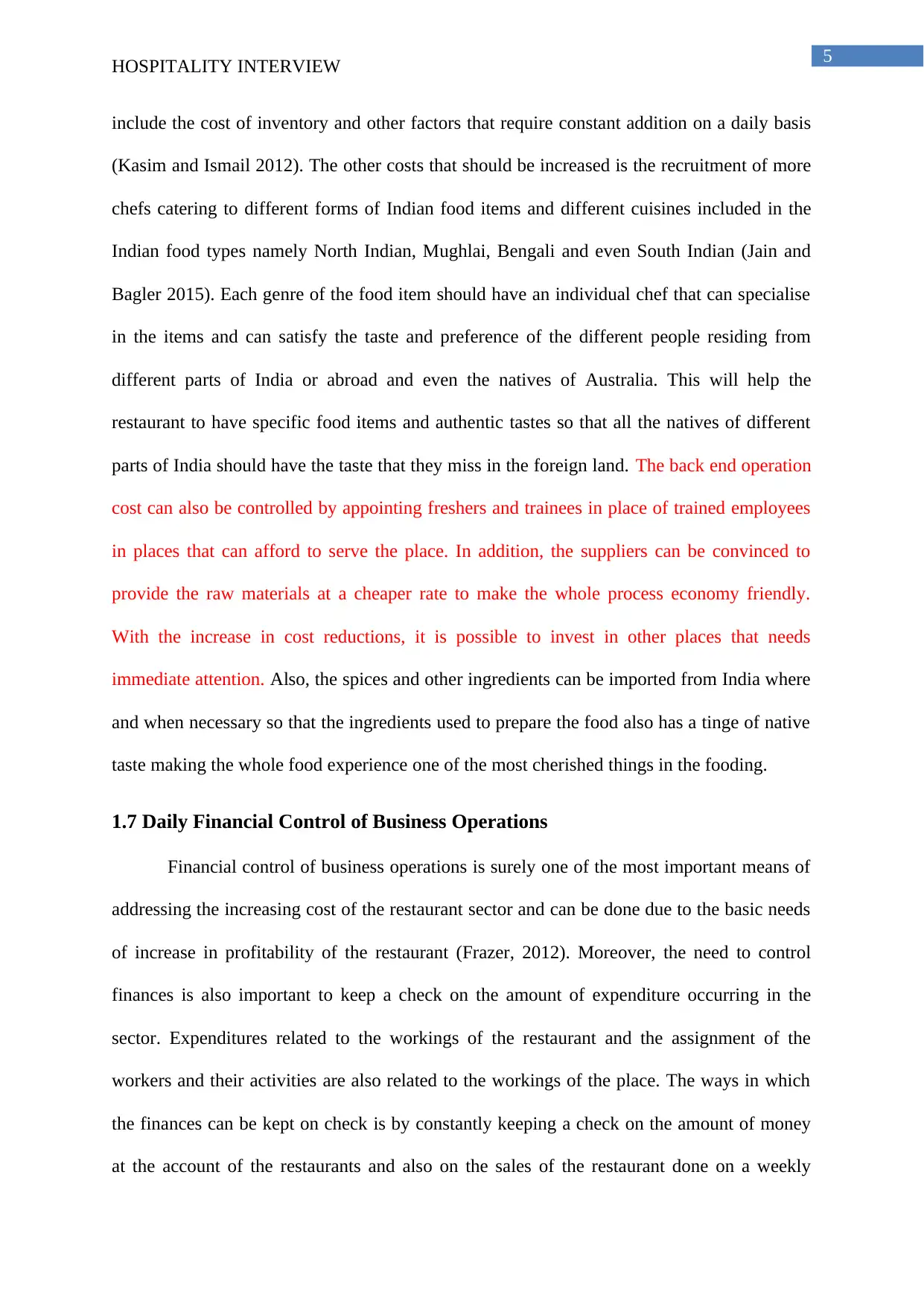
5
HOSPITALITY INTERVIEW
include the cost of inventory and other factors that require constant addition on a daily basis
(Kasim and Ismail 2012). The other costs that should be increased is the recruitment of more
chefs catering to different forms of Indian food items and different cuisines included in the
Indian food types namely North Indian, Mughlai, Bengali and even South Indian (Jain and
Bagler 2015). Each genre of the food item should have an individual chef that can specialise
in the items and can satisfy the taste and preference of the different people residing from
different parts of India or abroad and even the natives of Australia. This will help the
restaurant to have specific food items and authentic tastes so that all the natives of different
parts of India should have the taste that they miss in the foreign land. The back end operation
cost can also be controlled by appointing freshers and trainees in place of trained employees
in places that can afford to serve the place. In addition, the suppliers can be convinced to
provide the raw materials at a cheaper rate to make the whole process economy friendly.
With the increase in cost reductions, it is possible to invest in other places that needs
immediate attention. Also, the spices and other ingredients can be imported from India where
and when necessary so that the ingredients used to prepare the food also has a tinge of native
taste making the whole food experience one of the most cherished things in the fooding.
1.7 Daily Financial Control of Business Operations
Financial control of business operations is surely one of the most important means of
addressing the increasing cost of the restaurant sector and can be done due to the basic needs
of increase in profitability of the restaurant (Frazer, 2012). Moreover, the need to control
finances is also important to keep a check on the amount of expenditure occurring in the
sector. Expenditures related to the workings of the restaurant and the assignment of the
workers and their activities are also related to the workings of the place. The ways in which
the finances can be kept on check is by constantly keeping a check on the amount of money
at the account of the restaurants and also on the sales of the restaurant done on a weekly
HOSPITALITY INTERVIEW
include the cost of inventory and other factors that require constant addition on a daily basis
(Kasim and Ismail 2012). The other costs that should be increased is the recruitment of more
chefs catering to different forms of Indian food items and different cuisines included in the
Indian food types namely North Indian, Mughlai, Bengali and even South Indian (Jain and
Bagler 2015). Each genre of the food item should have an individual chef that can specialise
in the items and can satisfy the taste and preference of the different people residing from
different parts of India or abroad and even the natives of Australia. This will help the
restaurant to have specific food items and authentic tastes so that all the natives of different
parts of India should have the taste that they miss in the foreign land. The back end operation
cost can also be controlled by appointing freshers and trainees in place of trained employees
in places that can afford to serve the place. In addition, the suppliers can be convinced to
provide the raw materials at a cheaper rate to make the whole process economy friendly.
With the increase in cost reductions, it is possible to invest in other places that needs
immediate attention. Also, the spices and other ingredients can be imported from India where
and when necessary so that the ingredients used to prepare the food also has a tinge of native
taste making the whole food experience one of the most cherished things in the fooding.
1.7 Daily Financial Control of Business Operations
Financial control of business operations is surely one of the most important means of
addressing the increasing cost of the restaurant sector and can be done due to the basic needs
of increase in profitability of the restaurant (Frazer, 2012). Moreover, the need to control
finances is also important to keep a check on the amount of expenditure occurring in the
sector. Expenditures related to the workings of the restaurant and the assignment of the
workers and their activities are also related to the workings of the place. The ways in which
the finances can be kept on check is by constantly keeping a check on the amount of money
at the account of the restaurants and also on the sales of the restaurant done on a weekly
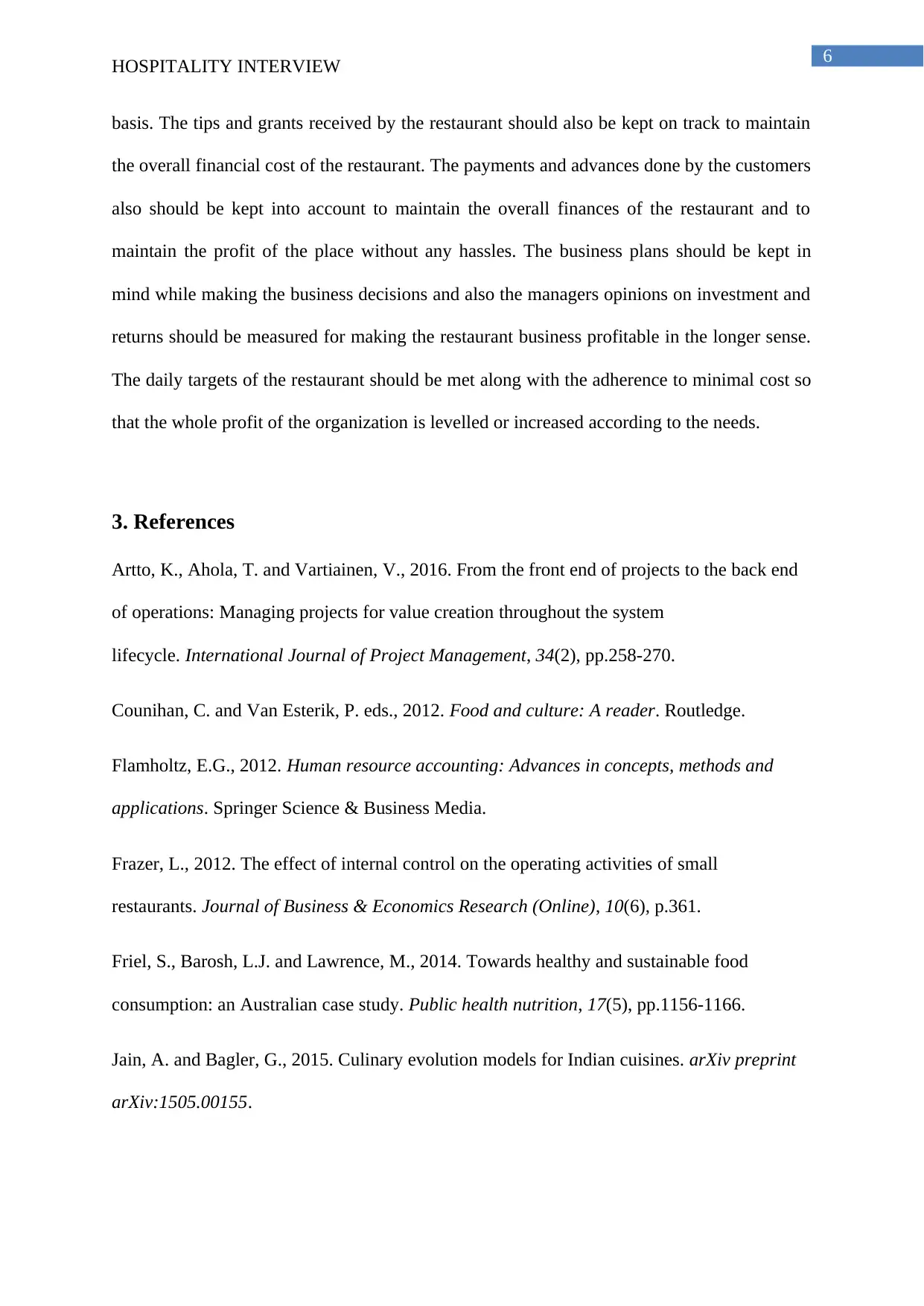
6
HOSPITALITY INTERVIEW
basis. The tips and grants received by the restaurant should also be kept on track to maintain
the overall financial cost of the restaurant. The payments and advances done by the customers
also should be kept into account to maintain the overall finances of the restaurant and to
maintain the profit of the place without any hassles. The business plans should be kept in
mind while making the business decisions and also the managers opinions on investment and
returns should be measured for making the restaurant business profitable in the longer sense.
The daily targets of the restaurant should be met along with the adherence to minimal cost so
that the whole profit of the organization is levelled or increased according to the needs.
3. References
Artto, K., Ahola, T. and Vartiainen, V., 2016. From the front end of projects to the back end
of operations: Managing projects for value creation throughout the system
lifecycle. International Journal of Project Management, 34(2), pp.258-270.
Counihan, C. and Van Esterik, P. eds., 2012. Food and culture: A reader. Routledge.
Flamholtz, E.G., 2012. Human resource accounting: Advances in concepts, methods and
applications. Springer Science & Business Media.
Frazer, L., 2012. The effect of internal control on the operating activities of small
restaurants. Journal of Business & Economics Research (Online), 10(6), p.361.
Friel, S., Barosh, L.J. and Lawrence, M., 2014. Towards healthy and sustainable food
consumption: an Australian case study. Public health nutrition, 17(5), pp.1156-1166.
Jain, A. and Bagler, G., 2015. Culinary evolution models for Indian cuisines. arXiv preprint
arXiv:1505.00155.
HOSPITALITY INTERVIEW
basis. The tips and grants received by the restaurant should also be kept on track to maintain
the overall financial cost of the restaurant. The payments and advances done by the customers
also should be kept into account to maintain the overall finances of the restaurant and to
maintain the profit of the place without any hassles. The business plans should be kept in
mind while making the business decisions and also the managers opinions on investment and
returns should be measured for making the restaurant business profitable in the longer sense.
The daily targets of the restaurant should be met along with the adherence to minimal cost so
that the whole profit of the organization is levelled or increased according to the needs.
3. References
Artto, K., Ahola, T. and Vartiainen, V., 2016. From the front end of projects to the back end
of operations: Managing projects for value creation throughout the system
lifecycle. International Journal of Project Management, 34(2), pp.258-270.
Counihan, C. and Van Esterik, P. eds., 2012. Food and culture: A reader. Routledge.
Flamholtz, E.G., 2012. Human resource accounting: Advances in concepts, methods and
applications. Springer Science & Business Media.
Frazer, L., 2012. The effect of internal control on the operating activities of small
restaurants. Journal of Business & Economics Research (Online), 10(6), p.361.
Friel, S., Barosh, L.J. and Lawrence, M., 2014. Towards healthy and sustainable food
consumption: an Australian case study. Public health nutrition, 17(5), pp.1156-1166.
Jain, A. and Bagler, G., 2015. Culinary evolution models for Indian cuisines. arXiv preprint
arXiv:1505.00155.
Paraphrase This Document
Need a fresh take? Get an instant paraphrase of this document with our AI Paraphraser
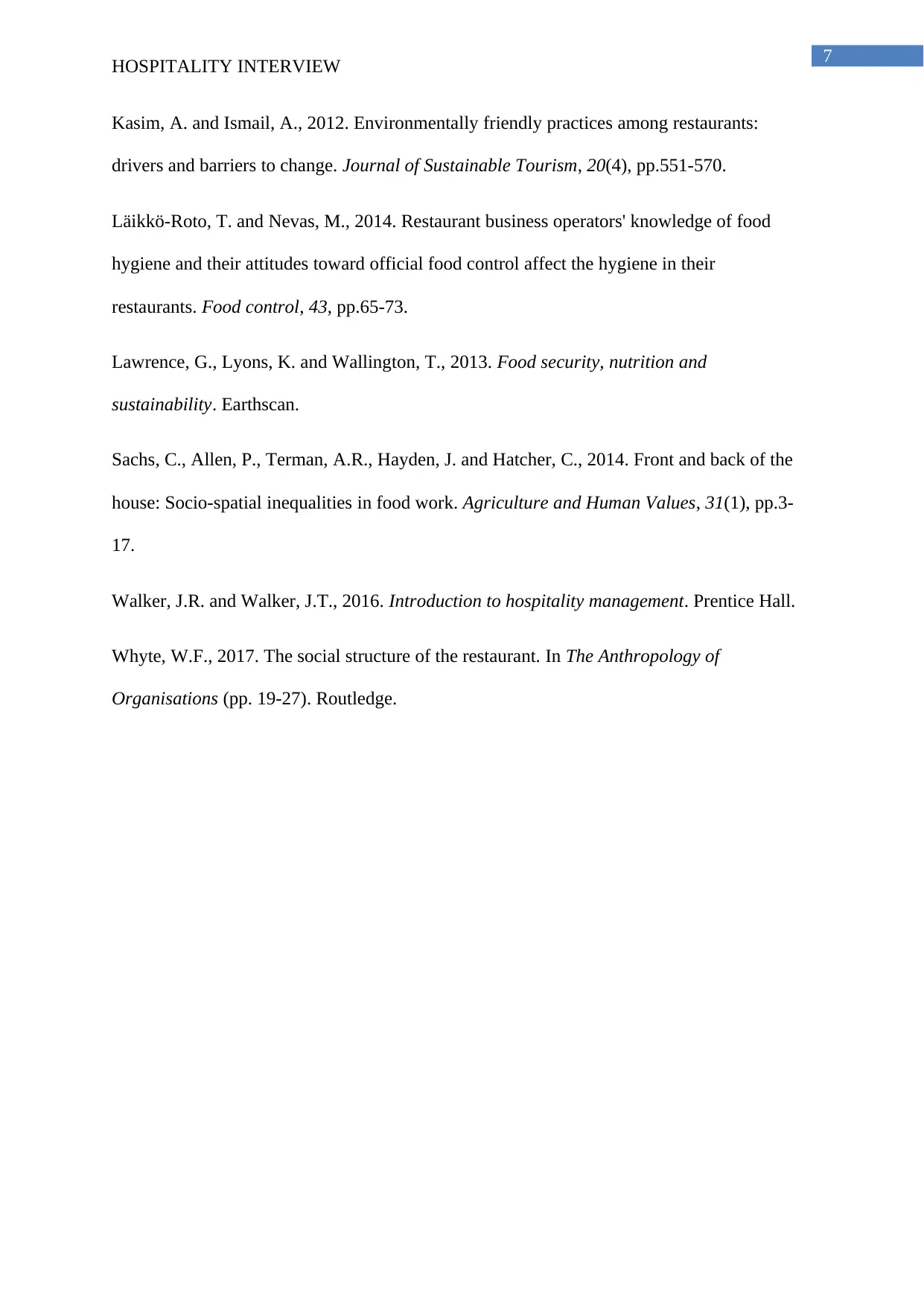
7
HOSPITALITY INTERVIEW
Kasim, A. and Ismail, A., 2012. Environmentally friendly practices among restaurants:
drivers and barriers to change. Journal of Sustainable Tourism, 20(4), pp.551-570.
Läikkö-Roto, T. and Nevas, M., 2014. Restaurant business operators' knowledge of food
hygiene and their attitudes toward official food control affect the hygiene in their
restaurants. Food control, 43, pp.65-73.
Lawrence, G., Lyons, K. and Wallington, T., 2013. Food security, nutrition and
sustainability. Earthscan.
Sachs, C., Allen, P., Terman, A.R., Hayden, J. and Hatcher, C., 2014. Front and back of the
house: Socio-spatial inequalities in food work. Agriculture and Human Values, 31(1), pp.3-
17.
Walker, J.R. and Walker, J.T., 2016. Introduction to hospitality management. Prentice Hall.
Whyte, W.F., 2017. The social structure of the restaurant. In The Anthropology of
Organisations (pp. 19-27). Routledge.
HOSPITALITY INTERVIEW
Kasim, A. and Ismail, A., 2012. Environmentally friendly practices among restaurants:
drivers and barriers to change. Journal of Sustainable Tourism, 20(4), pp.551-570.
Läikkö-Roto, T. and Nevas, M., 2014. Restaurant business operators' knowledge of food
hygiene and their attitudes toward official food control affect the hygiene in their
restaurants. Food control, 43, pp.65-73.
Lawrence, G., Lyons, K. and Wallington, T., 2013. Food security, nutrition and
sustainability. Earthscan.
Sachs, C., Allen, P., Terman, A.R., Hayden, J. and Hatcher, C., 2014. Front and back of the
house: Socio-spatial inequalities in food work. Agriculture and Human Values, 31(1), pp.3-
17.
Walker, J.R. and Walker, J.T., 2016. Introduction to hospitality management. Prentice Hall.
Whyte, W.F., 2017. The social structure of the restaurant. In The Anthropology of
Organisations (pp. 19-27). Routledge.
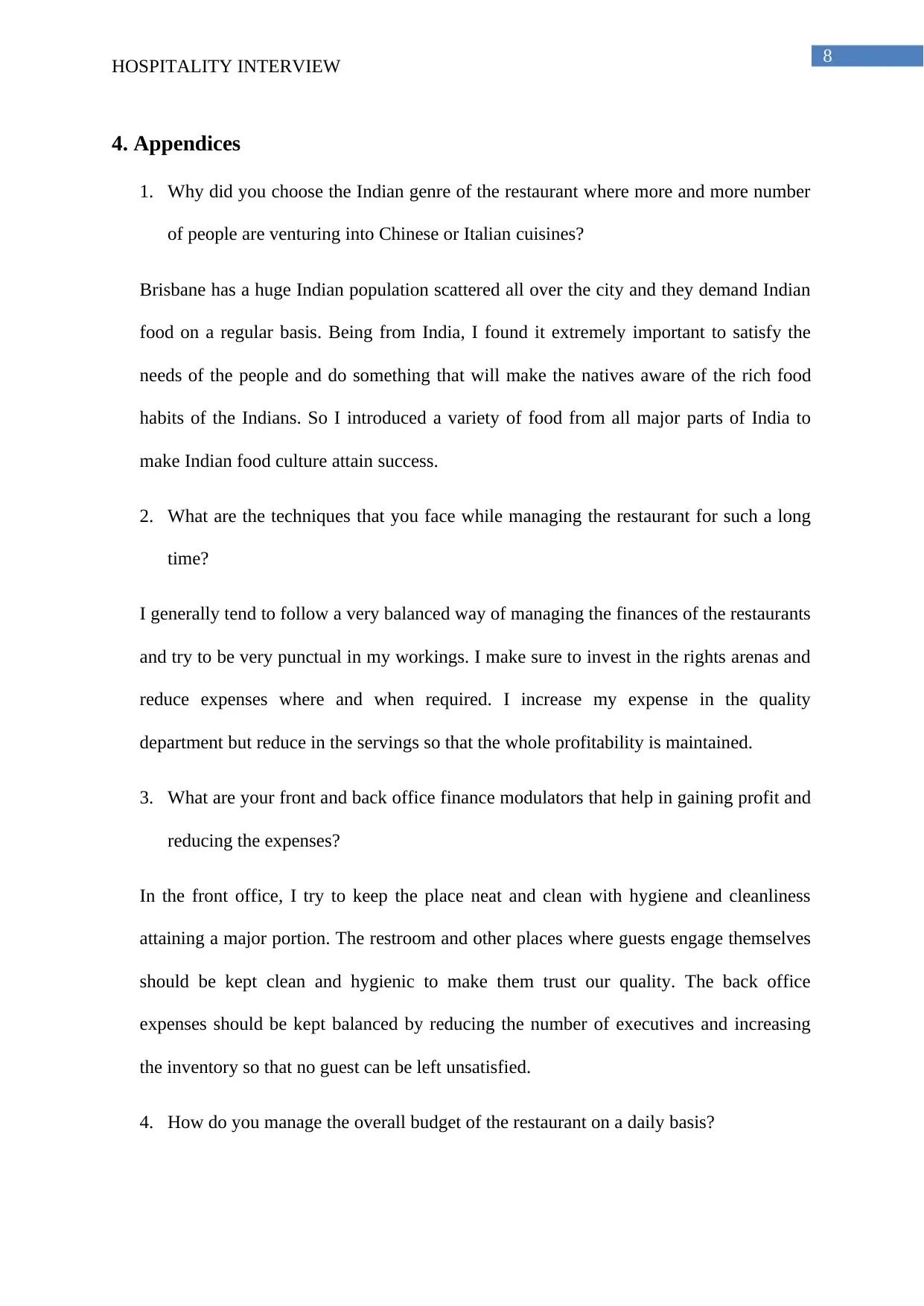
8
HOSPITALITY INTERVIEW
4. Appendices
1. Why did you choose the Indian genre of the restaurant where more and more number
of people are venturing into Chinese or Italian cuisines?
Brisbane has a huge Indian population scattered all over the city and they demand Indian
food on a regular basis. Being from India, I found it extremely important to satisfy the
needs of the people and do something that will make the natives aware of the rich food
habits of the Indians. So I introduced a variety of food from all major parts of India to
make Indian food culture attain success.
2. What are the techniques that you face while managing the restaurant for such a long
time?
I generally tend to follow a very balanced way of managing the finances of the restaurants
and try to be very punctual in my workings. I make sure to invest in the rights arenas and
reduce expenses where and when required. I increase my expense in the quality
department but reduce in the servings so that the whole profitability is maintained.
3. What are your front and back office finance modulators that help in gaining profit and
reducing the expenses?
In the front office, I try to keep the place neat and clean with hygiene and cleanliness
attaining a major portion. The restroom and other places where guests engage themselves
should be kept clean and hygienic to make them trust our quality. The back office
expenses should be kept balanced by reducing the number of executives and increasing
the inventory so that no guest can be left unsatisfied.
4. How do you manage the overall budget of the restaurant on a daily basis?
HOSPITALITY INTERVIEW
4. Appendices
1. Why did you choose the Indian genre of the restaurant where more and more number
of people are venturing into Chinese or Italian cuisines?
Brisbane has a huge Indian population scattered all over the city and they demand Indian
food on a regular basis. Being from India, I found it extremely important to satisfy the
needs of the people and do something that will make the natives aware of the rich food
habits of the Indians. So I introduced a variety of food from all major parts of India to
make Indian food culture attain success.
2. What are the techniques that you face while managing the restaurant for such a long
time?
I generally tend to follow a very balanced way of managing the finances of the restaurants
and try to be very punctual in my workings. I make sure to invest in the rights arenas and
reduce expenses where and when required. I increase my expense in the quality
department but reduce in the servings so that the whole profitability is maintained.
3. What are your front and back office finance modulators that help in gaining profit and
reducing the expenses?
In the front office, I try to keep the place neat and clean with hygiene and cleanliness
attaining a major portion. The restroom and other places where guests engage themselves
should be kept clean and hygienic to make them trust our quality. The back office
expenses should be kept balanced by reducing the number of executives and increasing
the inventory so that no guest can be left unsatisfied.
4. How do you manage the overall budget of the restaurant on a daily basis?
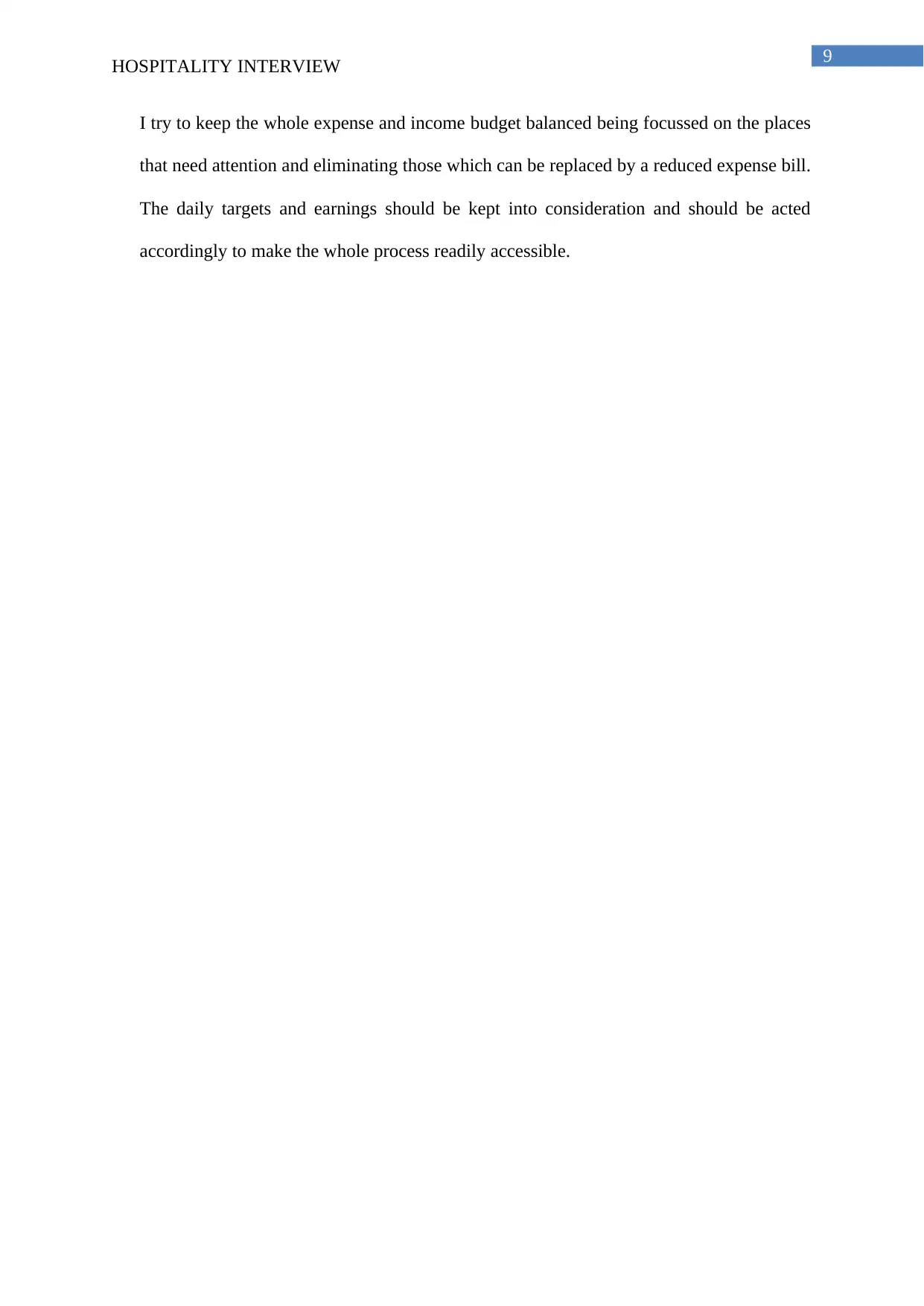
9
HOSPITALITY INTERVIEW
I try to keep the whole expense and income budget balanced being focussed on the places
that need attention and eliminating those which can be replaced by a reduced expense bill.
The daily targets and earnings should be kept into consideration and should be acted
accordingly to make the whole process readily accessible.
HOSPITALITY INTERVIEW
I try to keep the whole expense and income budget balanced being focussed on the places
that need attention and eliminating those which can be replaced by a reduced expense bill.
The daily targets and earnings should be kept into consideration and should be acted
accordingly to make the whole process readily accessible.
1 out of 10
Related Documents
Your All-in-One AI-Powered Toolkit for Academic Success.
+13062052269
info@desklib.com
Available 24*7 on WhatsApp / Email
![[object Object]](/_next/static/media/star-bottom.7253800d.svg)
Unlock your academic potential
© 2024 | Zucol Services PVT LTD | All rights reserved.





